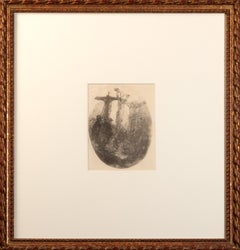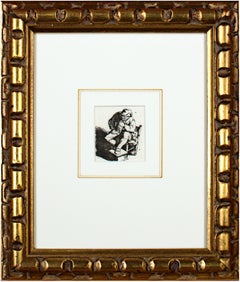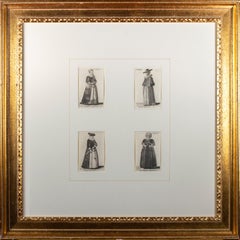Want more images or videos?
Request additional images or videos from the seller
1 of 7
Rembrandt van Rijn'Christ Crucified Between Two Thieves: an oval plate' Rembrandt original etching1641
1641
$12,850List Price
About the Item
- Creator:Rembrandt van Rijn (1606 - 1669, Dutch)
- Creation Year:1641
- Dimensions:Height: 15.75 in (40.01 cm)Width: 14.5 in (36.83 cm)
- Medium:
- Movement & Style:
- Period:1640-1649
- Condition:Overall good condition; some wrinkles in upper corners; some light discoloration and foxing.
- Gallery Location:Milwaukee, WI
- Reference Number:Seller: 12706g1stDibs: LU60537869882
Rembrandt van Rijn
Rembrandt was the most influential 17th Century Dutch painter. After years of early success as a portrait painter, his life was beset by financial hardship and personal tragedy. He continued to paint portraits and develop etchings. Rembrandt's portraits of his contemporaries, self-portraits and illustrations of scenes from the Bible are regarded as his greatest creative triumphs. His self-portraits form a unique and intimate autobiography, in which the artist surveyed himself without vanity and with the utmost sincerity. Like many artists of the Dutch Golden Age, such as Jan Vermeer of Delft, Rembrandt was also an avid art collector and dealer. Rembrandt never went abroad, but he was considerably influenced by the work of the Italian masters and Netherlandish artists who had studied in Italy, like Pieter Lastman, the Utrecht Caravaggists, Flemish Baroque, and Peter Paul Rubens. Rembrandt's foremost contribution in the history of printmaking was his transformation of the etching process from a relatively new reproductive technique into a true art form, along with Jacques Callot. His reputation as the greatest etcher in the history of the medium was established in his lifetime and never questioned since. Few of his paintings left the Dutch Republic while he lived, but his prints were circulated throughout Europe, and his wider reputation was initially based on them alone.
About the Seller
4.9
Gold Seller
Premium sellers maintaining a 4.3+ rating and 24-hour response times
Established in 1966
1stDibs seller since 2017
451 sales on 1stDibs
Typical response time: 2 hours
Authenticity Guarantee
In the unlikely event there’s an issue with an item’s authenticity, contact us within 1 year for a full refund. DetailsMoney-Back Guarantee
If your item is not as described, is damaged in transit, or does not arrive, contact us within 7 days for a full refund. Details24-Hour Cancellation
You have a 24-hour grace period in which to reconsider your purchase, with no questions asked.Vetted Professional Sellers
Our world-class sellers must adhere to strict standards for service and quality, maintaining the integrity of our listings.Price-Match Guarantee
If you find that a seller listed the same item for a lower price elsewhere, we’ll match it.Trusted Global Delivery
Our best-in-class carrier network provides specialized shipping options worldwide, including custom delivery.You May Also Like
The Ship Builder and His Wife by Johannes Pieter de Frey
By Rembrandt van Rijn
Located in Middletown, NY
Etching with engraving on cream laid paper which is watermarked with a fancy "M," 9 1/2 x 12 3/16 inches (240 x 308 mm), narrow margins. In good condition with some scattered light a...
Category
Early 19th Century Dutch School Portrait Prints
Materials
Laid Paper, Engraving, Etching
Moulins de Hollande
By Johan Barthold Jongkind
Located in Middletown, NY
Etching on cream laid paper. 5 7/16x7 7/16 inches (137 x 188 mm). Scattered toning, age stain, and scattered minor defects consistent with age. Second state (of 3).
[Delteil 14]
Jo...
Category
19th Century Dutch School Landscape Prints
Materials
Etching, Laid Paper
Bouquet of Flowers
By Cornelis Ploos van Amstel
Located in New York, NY
A supberb impression of this extremely scarce and early color etching after Jan van Huysum. With the artist's ink stamp.
Category
1770s Dutch School Still-life Prints
Materials
Color, Etching
Saint Paul, from the series of Standing Saints
By Lucas van Leyden
Located in Middletown, NY
Engraving on cream laid paper laid down to wove paper, 4 1/4 x 2 5/8 inches (109 x 68), trimmed inside the platemark. Scattered discoloration and uniform age tone, all consistent wit...
Category
16th Century Dutch School Figurative Prints
Materials
Laid Paper, Engraving
Buitenzijde Van Het Colosseum (Exterior of the Colosseum)
Located in Middletown, NY
The Hague: circa 1799.
Engraving with burin on cream laid paper, 7 7/8 x 13 inches (198 x 330 mm) full margins. Octavo fold with additional hard creases with an associated loss in t...
Category
Late 18th Century Dutch School Figurative Prints
Materials
Laid Paper, Engraving
Interior with Red Shawl (Young woman reads in this calm Vermeer-like interior)
Located in New Orleans, LA
Interior with a red shawl conveys a quite different mood and feeling: one of calm, and suspension of time. Here the suggestion is that the woman is waiting ...
Category
Early 20th Century Dutch School Figurative Prints
Materials
Mezzotint
$6,000 Sale Price
20% Off
H 19.25 in W 16 in
Aurora sive Tempus Matutinum; Der Wohl und Übel angewandte Morgen /// Old Master
Located in Saint Augustine, FL
Artist: (after) Johann Daniel Preissler (German, 1666-1737)
Title: "Aurora sive Tempus Matutinum; Der Wohl und Übel angewandte Morgen (Dawn or Morning Time; The Morning Used for Better or For Worse)"
Portfolio: Die Vier Tageszeiten (The Four Times of Day)
Year: 1723
Medium: Original Etching and Engraving on laid paper
Limited edition: Unknown
Printer: likely Johann Balthasar Probst, Augsburg, Germany
Publisher: Jeremias Wolff (Erben), Augsburg, Germany
Reference: Le Blanc No. 255, 38; Nagler No. 23
Sheet size: 22.57" x 16.38"
Image size: 17.75" x 14"
Condition: Soft handling creases, folds, and scattered faint areas of discoloration to sheet. Three tears skillfully repaired from verso. Has been professionally stored away for decades. It is otherwise a strong impression in good condition with full margins
Extremely rare
Notes:
Provenance: private collection - Aspen, CO. Engraved by German artist Johann Balthasar Probst (1673-1750) after a drawing by German artist Johann Daniel Preissler (1666-1737). Comes from Preissler's 1723 "Die Vier Tageszeiten (The Four Times of Day)" portfolio of four etchings and engravings. Printed from one copper plate in one color: black. Descriptions of the portrayed image are printed in Latin and German.
Biography:
Johann Daniel Preissler, or Preisler (1666–1737) was a German painter and director of Nuremberg's Academy of Fine Arts. He was a notable member of a German artistic family, originating in Bohemia. His children included Johann Justin Preissler (1698–1771), Georg Martin Preisler (1700–1754), Barbara Helena Preisler (1707–1758; married to Oeding), Johan Martin Preisler (1715–1794), and Valentin Daniel Preisler (1717–1765), all in their time renowned artists. Most notable for his portraits, nudes and history paintings, Johann Daniel Preissler also produced drawings and frescoes. He was particularly known beyond his native Nuremberg for his "Die durch Theorie erfundene Practic", a sequence of works on art theory – the individual works were translated into several other languages and served as textbooks for students such as the Swiss Salomon Gessner...
Category
1720s Old Masters Figurative Prints
Materials
Laid Paper, Engraving, Etching
$900
H 22.57 in W 16.38 in
Le Bouquet de Violettes (The Bouquet of Violets) /// Figurative Impressionist
By Manuel Robbe
Located in Saint Augustine, FL
Artist: Manuel Robbe (French, 1872-1936)
Title: "Le Bouquet de Violettes (The Bouquet of Violets)"
*Signed by Robbe in pencil lower right
Year: 1903
Medium: Original Hand-Colored Etc...
Category
Early 1900s Post-Impressionist Figurative Prints
Materials
Watercolor, Laid Paper, Etching, Aquatint, Intaglio
Meeting, paper/etching, 11.5x12.5 cm
Located in Riga, LV
Meeting, paper/etching, 11.5x12.5 cm
Category
1980s Symbolist Figurative Prints
Materials
Paper, Etching
$567 Sale Price
20% Off
H 4.73 in W 5.12 in D 0.04 in
Session VI, paper/etching, 63/75, 11x12 cm, 1988
Located in Riga, LV
Session VI, paper/etching, 63/75, 11x12 cm, 1988
Category
1980s Symbolist Figurative Prints
Materials
Paper, Etching
$568 Sale Price
20% Off
H 4.34 in W 4.73 in D 0.04 in
More From This Seller
View All17th century etching Rembrandt biblical scene crucifixion figures
By Rembrandt van Rijn
Located in Milwaukee, WI
Rembrandt's print 'Christ Crucified Between Two Thieves: an oval plate' is one of the most captivating of the artist's oeuvre. Etched to an oval rather than a rectangular plate and t...
Category
1640s Dutch School Figurative Prints
Materials
Paper, Etching, Printer's Ink, Drypoint
'The Smoker (Le Fumeur)' original etching by Cornelis-Pietersz Bega
By Cornelis Bega
Located in Milwaukee, WI
'The Smoker (Le Fumeur)' is an original etching by the celebrated Dutch painter and printmaker Cornelis-Pietersz Bega. It presents a genre scene of the type Bega was best known for: Bega's principal subjects were genre representations of taverns, domestic interiors and villages. He depicted nursing mothers, prostitutes, drunks, gamblers and fools such as quack doctors and alchemists. In this case, he shows a man seated on a chair with his foot on a flat stool and holding a smoking pipe. For Bega, this representation was more of a caricature than it was an image of a specific person, and such genre scenes would have held allegorical and symbolic meaning for the seventeenth-century viewer. During the seventeenth century, the Dutch of all levels of society consumed tobacco and alcohol, and these were an important part of the Dutch economy and a major source of wealth. At the same time, however, moralists and ministers sought to curb intoxication: they openly described drinking and smoking as sinful, immoral, and a general threat to one’s reputation. This paradox is reflected in prints such as this, which inherently carry the national pride of the Dutch economy alongside a moral warning in a print that could be just as easily consumed and collected.
2.5 x 2.25 inches, print
12.38 x 10.38 inches, frame
Framed to conservation standards using archival materials including 100 percent rag matting and mounting materials. Housed in a gold finish Spanish-style wood moulding.
Overall good and stable condition; margins cut to plate; some wrinkling in the corners from previous mounting; housed in a new custom frame.
Cornelis Bega was born into prosperous circumstances. His mother, Maria Cornelis, inherited half the estate (gold, silver, paintings, drawings and prints) and all of the red chalk drawings of her father, Cornelis Cornelisz van Haarlem, a renowned Mannerist artist. Bega's father was Pieter Jansz Begijn (d 1648), a gold and silversmith.
Like other family members, Bega was probably Catholic. Houbraken's claim that Bega studied with Adriaen van Ostade is likely to be correct; this was probably before 24 April 1653, when Bega joined Vincent Laurentsz. van der Vinne in Frankfurt for a journey through Germany, Switzerland and France. Bega had returned to Haarlem by 1 September 1654, at which time he joined the Guild of St Luke; he was already a competent draughtsman, as indicated by his first extant dated work, Interior with a Nursing Mother (1652; Frankfurt am Main, Städel. Kstinst.), and by a remarkable double portrait (Amsterdam, Rijksmuseum) drawn by him and Leendert van der Cooghen in 1654.
Bega painted, drew, etched and made counterproofs in a wide variety of materials on different types of small-scale supports. He may have been the first Dutch artist to make monotypes, but this remains controversial. Approximately 160 paintings, 80 drawings and six monotypes by Bega have been catalogued, as well as around 34 etchings.
Bega's principal subjects were genre representations of taverns, domestic interiors and villages. He depicted nursing mothers, prostitutes, drunks, smokers, gamblers and fools such as quack doctors and alchemists. Less common subjects include the ridiculed or pestered woman, as in Two Figures and Mother with a Spirits Bottle (c. 1662; Gouda, Stedel, Museum Catharina Gasthuis) and The Inn (etching), as well as witty satires on traditional scenes of middle-class music-makers, such as the Music Lesson (1663; Paris, Petit Palace).
Bega's early paintings, such as the Weaver's Family (c. 1652; St Petersburg, Hermitage), are freely executed, dark and coarse, recalling the many-figured peasant subjects of van Ostade. Between c. 1660 and 1664 he began to paint genre scenes with fewer figures, which are finely articulated, colourful and psychologically expressive, for example Two Men Singing (1662; Dublin, N.G.). His exquisite, late fijnschilderen ('fine painting') manner, evident in The Alchemist (1663; Malibu, Getty Museum), compares well with that of Gerrit Dou.
As a draughtsman Bega is noted for his single-figure studies, executed mainly in black and white chalk on blue paper or red chalk on white paper. None of the studies, which were drawn naer het leven (from life), seem to relate to a painting or etching. Bega traded drawings or shared models with other artists of the Haarlem school, including van der Cooghen, Gerrit Berckheyde, Dirck Helmbreker and Cornelis Visscher. These artists drew chalk figure studies in a very similar style, characterised by regular and precise parallel shading and well-defined forms; their drawings, especially those of Bega and Berckheyde, have been frequently confused. Unlike the realistic figure studies, Bega's etchings depict interiors with figures or single figures in the manner of van Ostade; the compositions, often with masterful chiaroscuro effects, reflect most closely the paintings of the 1650s.
Bega is likely to have remained in Haarlem, where he paid dues to the Guild in 1661. He probably died from the plague; fees for his expensive funeral at St. Bavo's were paid on 30 August 1664. Among the artists he influenced were Thomas Wijck, Jan Steen, Richard Brakenburg (1650-1702) and Cornelis Dusart. Painters such as R. Oostrzaen ( fl ?1656) and Jacob Toorenvliet...
Category
17th Century Old Masters Figurative Prints
Materials
Paper, Etching
Four original etchings of women from 'Aula Veneris' series by Wenceslaus Hollar
By Wenceslaus Hollar
Located in Milwaukee, WI
Presented here as a group are four original etchings of women in European national dress from the master printmaker Wenceslaus Hollar's series "Aula V...
Category
17th Century Old Masters Figurative Prints
Materials
Etching, Paper
'Self Portrait 1974' original etching signed by Sandra Sweeney
By Sandra Sweeney
Located in Milwaukee, WI
Following in line with artists before her, like Rembrandt and van Gogh, Sandra Sweeny here presents a self portrait. The image is both direct and subtle not only in its handling of m...
Category
1970s Contemporary Portrait Prints
Materials
Paper, Etching
18th century etching figurative neoclassical mythology scene dynamic
By Alexander Runciman
Located in Milwaukee, WI
"Cormar Attacking a Spirit on the Waters" is an etching by eighteenth-century Scottish artist Alexander Runciman, signed in plate on the lower edge of the etching, "ARunciman inv. & ...
Category
1770s Academic Figurative Prints
Materials
Etching, Paper, Ink
20th century aquatint etching figurative portrait ink unfinished female subject
By Moishe Smith
Located in Milwaukee, WI
"Maria (Artist's Wife)" is an original etching by Moishe Smith, signed in the bottom right corner and numbered in the bottom left. The piece depicts a seated woman from the waist up,...
Category
1960s Post-Modern Figurative Prints
Materials
Paper, Etching, Aquatint
Recently Viewed
View AllMore Ways To Browse
Michel Delacroix Bicycles
Miller Botanical Prints
Mizuno Toshikata On Sale
Modigliani Lithographs Hand Signed
Mostly Mozart Poster
Mozart Engraving
Mr Brainwash Hold On
Mr Brainwash Mickey Mouse
Mustafa Ayaz On Sale
Nan Goldin Prints Poster
Natalie Henry
Navaja Knife
Nic Jonk On Sale
Nicola Samori
Opie New York Couple 7
Pablo Picasso Foundation
Pablo Picasso La Celestine
Pablo Picasso Poster For 1980 Moma Exhibition



